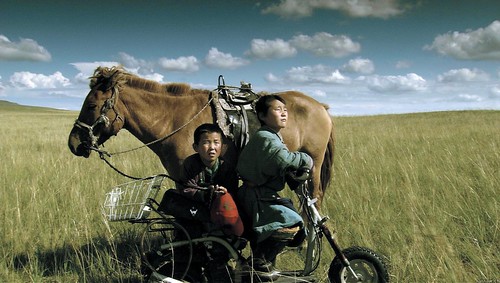I’m obviously a sucker for Mongolian movies. One of my favorite films ever is Urga, which was distributed in the
Genghis Blues is the 1999 documentary of a San Francisco street musician, the late Paul Peña, who manages not only to learn Tuvan throat singing, the deep music in which the singer literally sings two notes at once, but gets invited to Tuva, the Russian province immediately north of Mongolia, for a bi-annual throat-singing festival & contest, where he actually wins an award. To make this improbable but true story even stranger, a key figure in all of this is the late physicist Richard Feynman, who as one of the world’s leading scientists parlayed a childhood interest in stamps – he had one from Tuva back during the brief period when it was an independent nation prior to Soviet consolidation of its indigenous peoples that showed a race between hot air balloons and camels – into an exploration of a country that had disappeared. His foundation to this day sponsors cultural exchange activities between the
Lü cao di is a 2005 film by the Chinese director Ning Hao that tells the tale of three boys, roughly age 7, who live with a nomadic group which is starting to show signs of setting down roots, building yurts out of brick & attempting (with no success) to construct a windmill.
The three boys, Bilike, Dawa & Erguotou, discover a ping pong ball floating down the little spaghetti-thin curlicue of a river that runs by their clan’s settlement. Although these erstwhile nomads are far more modernized and westernized than the group in Urga – they have TV, t-shirts, Dawa wears a baseball cap while Erguotou zooms around the steppes on a small scooter, plus there are bottles & jars visible in the background in their yurts – the boys have no clue what this round object might be. Much prodding, holding it up against the light of the sky and licking it convinces them that it can’t be an egg, so that it must be a glowing pearl. They consult with a local lama, but since he’s only ten, he doesn’t have much more in the way of worldly experience. Later, the trio learn almost by accident that it is a ping pong ball – they don’t know what that means exactly & their informant says simply that it’s the “national game” – which leaves them with a further mystery. They have, they believe, “the national ball,” which they deduce must be a treasure. So it must be returned.
Interestingly, given that
There are other plots surrounding this central tale – the father’s attempt to modernize their living quarters (his mother’s complaint about the brick yurt is that it’s “square and uncomfortable”), an oldest daughter’s desire to join an ethnic dancing troupe that would require her to move to the unnamed city (it appears to be far too small to be
Two things for me really made this film fascinating. First is just watching how much this version of nomadic life had modernized from the Russian portrayal of 14 years earlier – one can sense the slow encroachment of globalization at the deepest level of people’s lives, such as the sister’s application of lipstick for her audition with the troupe.
The other was the photography by Du Jie. This is the most static motion picture I have ever seen – the camera, with surprisingly few exceptions, takes a position and if the action wanders off-screen, it doesn’t move to follow it. Scenes at night are shot with no illumination. Often the characters are at a middle distance with the panorama of the Mongolian steppes or grass fields & barren tundra of the
All three of these motion pictures are filmed by outsiders – tho there has been Mongolian cinema since the 1930s, the one true Mongolian-made film I’ve ever seen is The Story of the Weeping Camel – and it’s easy to see both in Urga and Lü cao di a wish to portray Mongolians as some variant of “noble savages.” But what separates both of these films from simply racist fare like The Gods Must Be Crazy is that the confrontation with the modern world, which in some form or other sets the action going in each, is framed precisely in terms of what impacts the outer world is having on the nomadic group. The clan isn’t running away from technology – it’s Bilike’s father who wants someone to build him his dream of a windmill – but it’s skeptical in what it appropriates. When they stop getting decent reception from their TV, it has less value than two goats.
¹ Urga literally is the original name of the Mongolian capital
² This is consistent with thinking of ping pong as the “national” game, which it may be in China, while the most popular sport in Mongolia proper is wrestling.






